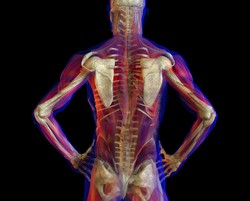Multiscale musculoskeletal knee models
Often considered an inevitable result of ageing, musculoskeletal diseases (MSDs) account for more than half of all chronic conditions in people over 50 years of age in developed countries. The EU-financed MULTISCALEHUMAN(opens in new window) (Multi-scale biological modalities for physiological human articulation) project involved seven institutes from four countries. The MULTISCALEHUMAN project has assembled an impressive collection of models and data from a variety of state-of-the-art imaging and tissue analysis technologies. Muscular activity of lower limbs was modelled from MR imaging and included details of muscle deformation during exercise. Working on the weight bearing function of the knee, two different ways of measuring cartilage thickness at the femur were devised to help with stress-related osteoarthritis (OA) assessments. An articulation model of the knee joint was created that incorporates detailed structures of bones, cartilage, menisci and ligaments. Collaboration within the project has integrated measurements of soft tissue (meniscus, cartilage) and joint kinematics into the model. Musculoskeletal models detected changes in muscle activations before and after total knee replacement. A CAD system working across multiple scales can support comparative analysis of clinical cases and evaluation of the patient's follow-up. A model of human OA cartilage shows the progression of the disease at molecular, cellular and tissue levels. An agent-based modelling approach promises to establish a more rapid, economical way to study molecular interactions rather than in the lab. Tissue engineering strategies for the knee meniscus and osteochondral tissues as well as optimised tissue engineering scaffolds were also developed. Research results have been presented at various conferences, workshops and meetings worldwide. So far, more than 40 publications have been published and two of these won best paper awards. All partners contributed their research to a book "3D Multiscale Physiological Human" published by Springer. The MULTISCALEHUMAN project has defined a strategy for an ontology based visualisation of multi-scale MSD data. Through its goals, the project has, and will continue to contribute to the emergence of personalised healthcare for MSD based on the fusion of information technology with medicine.







